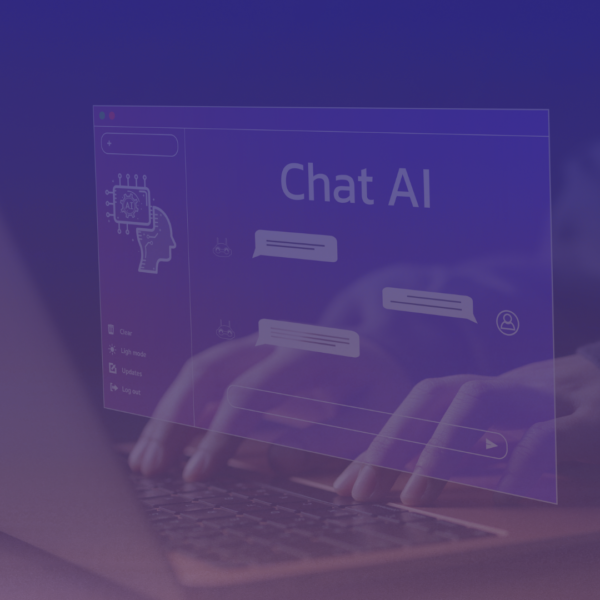
Written by Marten Wesebaum & Felice Valeria
Edited by Paul O’Brien
It was 30 November 2022 when the organisation OpenAI released its first artificial intelligence (AI) chat assistant, called ChatGPT. From that point on, the global focus shifted more and more towards the new technology, its capabilities and how it will shape and influence the future. Other major organisations have also released AIs in different areas, such as text-to-picture chats or text-to-video chats. The following article will attempt to discuss how this emerging technology will affect youth employment. As AI and youth employment have many different intersections, the article is divided into two categories: the macro-economic level and the individual employee level. As it is likely that many new AI solutions will be released over the next few years, this article provides a snapshot of the current environment and its influence on youth employment.
What are the effects on youth employment on an individual level?
At the individual level, the aim is to describe how jobseekers or young professionals in their first job can benefit or lose out from the use of AI. Before diving into the topic, it is crucial to mention that young people especially use AI. In the age range from 18 – 29 more than 50% have at least once made use of AI in their lives and 28% even use it several times a month (Blahošová, 2024). Under the premise that AI can enhance productivity and improve the quality of certain outputs, the younger age group that is currently using the new technology has an advantage towards the people that do not use it yet. Under favourable conditions, AI is able to drive productivity up by almost 40% (Somers, 2023). To use the new technology in such an effective way, it is crucial for the users to understand how to generate the best output and what tasks are possible for an AI to perform and what should still be done by a human. Therefore, training and experience are important factors when it comes to the usage of AI. The younger generation which is already using and experimenting with the new technology is already gaining experience and valuable insights, which prepare them for the labour market and might help them get the productivity boost of 40% mentioned earlier. Policymakers can take decisive steps to encourage young professionals to use AI more often for different tasks and to become better trained in its use. Currently, there are schools and universities that ban the new technology because of the risk of misinformation and plagiarism (Nolan, 2023). There are threats associated with its use, but banning it may be too extreme. Instead, policymakers should encourage educational institutions to implement guidelines to help them regulate the new technology. From today’s perspective, AI does not seem to be going away any time soon(Thomas, 2024), so students should be educated on how to use it properly.
AI can not only enhance productivity but also improve the learning experience for students. While textbooks are not designed to give any further explanations or examples, an AI can certainly do so. AI can also be used in order to create study material that is more vivid, and more appealing to students, thus enhancing their learning experience (Armellini et al., 2021). Especially text-to-video AIs can help create course material that involves various speakers and allows them to introduce different perspectives (Burchardt, 2023). Apart from that, AI provides the opportunity to move from the one-size fits all learning approach to a more individualised study plan (Datta et al., 2023). In most universities and schools, the content and pace of study are not tailored to the students’ own needs. The new technology however will enable educational institutions to create individualised syllabuses that take into account the students’ own abilities (Pangarkar, 2023). The assumption is that a study plan adapted to a student’s needs will ensure a better learning experience. Students whose learning experience has been enhanced by the usage of AI will strongly benefit from it when they enter the labour market, since good education correlates with job opportunities (OECD, 2012). At the moment, there is no AI model that could create such a personalised learning experience for education systems on a large scale. This is why policymakers should consider investing in such a technology. It will benefit not only the young people in the economy, but ultimately the economy itself due to the enhanced education of employees. Without embracing AI, education systems run the risk of being left behind, since many countries are already implementing the new technology (Lake, 2023).
Furthermore, with the implementation of AI in companies, there will also be a shift in skills that will be needed in order to remain relevant as an employee. In general terms, it is predicted that AI will overtake repetitive tasks (Sayegh, 2023). The skills that currently seem unlikely to be replaced by AI are: critical thinking, analytical thinking, technological literacy and creativity (Oxford University Press, 2023; Marr, 2022). It is recommendable for young professionals to further foster those skills where AI is having a hard time competing. This also leads to a recommendation for policymakers, who should ensure that these skills are adequately covered by state educational institutions. Consideration should be given to reducing the time spent learning the skills required for the repetitive tasks of the curriculum, as these are also likely to be replaced by AI in the future.
Despite all the benefits that AI can bring to youth employment, it is still crucial to know when to use and trust the new technology. Studies have shown that relying on a large language model for certain tasks can actually reduce the overall quality of the output. The study compared two groups, one of which was allowed to use an AI and the other was not. Both groups were then given quantitative and qualitative data to solve a business problem. The group with access to an AI did not perform as well as the control group (Candelon et al., 2023). This example illustrates how important it is for young professionals and jobseekers to distinguish between tasks where AI is applicable and those where it is not, in order to benefit from its use and not lose out. There are also cases where the use of AI and human labour require some balance, as both approaches have their weaknesses and trade-offs. This applies to leadership for instance. Employees appreciate the unbiased nature of AI, as it only looks at the quantity and quality of output, whereas human leaders may also take into account the personal experiences they have had with a particular person. On the other hand, employees distrust AI when it comes to personal matters and therefore still value interaction with a human supervisor. The new technology is very likely to be a productivity enhancer, but only if it is applied to the right tasks. Sometimes a hybrid approach is needed to tackle certain tasks, as illustrated by the example of leadership.
Apart from that when AI is asked to assist in decision-making, it may not be very accurate as it relies on the information that has been fed to the technology (Friend, 2023) and therefore may not be able to take into account all environmental conditions and outcomes as a human could do for decision-making. Since young people are currently the main users of the new technology (Blahošová, 2024) it is crucial to get them educated in a timely manner to avoid any mistakes that could occur due to incorrect applications of AI.
What are the effects of youth employment on a macroeconomic level?
This article also wants to analyse how the use of AI can either be beneficial or detrimental for a country’s macroeconomic circumstances, as it might affect the ways job functions are performed. In this case, AI is a double-edged sword, indeed. One of the major positive impacts of AI on youth employment lies in its ability to create new job opportunities in areas that were previously unexplored (Iacoviello, 2023). Machine learning engineers and data scientists, for example, will be in high demand following the rapid development of AI systems. As young people equipped with relevant skills and expertise in these domains can capitalise on emerging job opportunities, a country’s macroeconomic development could substantially improve. However, on the other hand, the development of AI could also potentially lead to job losses among young individuals as the technology could replace human workers to do their day-to-day tasks.
According to the World Economic Forum (2023), around three quarters of companies are planning to adopt AI to improve job growth. Automation could indeed optimise business processes, hence operating more efficiently. This increased productivity could lead to job creation across multiple sectors, which would indirectly benefit youth employment. Other than that, innovation and entrepreneurship could also be improved among individuals, since machine intelligence could help to facilitate the development of new products and services efficiently. For instance, generative AI, in this case, can help individuals to do “time-consuming” tasks that are expected when running a business, such as writing emails and answering phone calls (Brown, 2024). Furthermore, it can also assist individuals in brainstorming and figuring out what to do next in case they have any business ideas.
On the other hand, AI technologies could also contribute to the prevention and mitigation of various societal challenges related to sustainable development. The fact that AI has the ability to harness data and formulate innovative solutions could help in creating opportunities for young workers and mitigate workplace inequalities, thus improving their quality of life. For instance, AI can assist companies in identifying, understanding, and mitigating these inequalities by collecting data and monitoring labour-related issues (Makinde, 2024). By leveraging AI technologies to tackle pressing issues, young individuals can contribute to positive social impact while advancing their careers.
Nevertheless, despite its potential benefits, machine intelligence could also pose various challenges to youth employment at the macroeconomic level. As mentioned earlier, job displacement could emerge because of the massive development of AI technologies. According to Goldman Sachs (2023), it is likely for AI to displace around 300 million full-time jobs across the globe, which could affect up to two-thirds of jobs in Europe and the United States. Furthermore, according to McKinsey Global Institute (2023), it is estimated that around 12 million people have to change professions by 2030 due to the rapid development of new technologies. Indeed, the automation of jobs traditionally performed by young workers is likely to happen. The automation done by AI could lead to job displacement and the restructuring of labour markets. As AI-driven automation progresses, traditional roles that have historically served as entry points for young workers may become increasingly scarce. These roles often involve repetitive tasks that are easily automated, such as data entry and clerical work. Consequently, young individuals seeking employment in these sectors may encounter challenges as these positions diminish in availability (Ford, 2015). As a result, young workers may face challenges finding employment in roles that have increasingly been automated (Acemoglu & Restrepo, 2018). This would result in the rise of the unemployment percentage among young people.
Automation itself could also aggravate existing inequalities in the labour market, which would widen the gap between skilled and unskilled workers, as well as between developed and developing countries. Those who have limited access to education and training opportunities may be unfairly affected by job displacement and economic insecurity (Autor, 2015). This could lead to increased unemployment rates and socio-economic disparities among youth populations, particularly in developing countries. According to the International Monetary Fund (2024), the lower AI exposure in emerging markets (40%) compared to developed countries (60%) also showcases the risk of the widening gap between these countries since the former have easier access to AI, which would disadvantage the latter in terms of AI adjustment and leverage.
The advancement of AI technologies can also lead to a mismatch between the skills demanded by the labour market and those possessed by young job seekers. There might be an increased demand for non-routine analytical and interpersonal skills as routine tasks become automated. Without adequate training and education in AI-related fields, young workers may struggle to adapt to changing labour market dynamics, leading to skills mismatches and unemployment. This mismatch between skills supply and demand further aggravates existing inequalities in the labour market.
Policy Recommendations
While the rapid development of AI technologies might pose numerous societal challenges at the macroeconomic level, the benefits of such technologies could be used to mitigate the potential consequences. Hence, policymakers are recommended to carry out the following:
- Implement inclusive education and training programmes to improve the skills of young workers to be able to adapt with the rapid development of AI. Training programmes can be held regularly by companies and governments in regard to AI technologies. STEM education could be promoted to increase the employability of young people in AI-related sectors. However, a high priority should be put on young people with low-income backgrounds since they would barely have access to the education and training programmes. They should be made as inclusive as possible.
- Encourage companies to involve employees in decision-making processes about technology usage, since employees might know more about what tasks can be effectively automated by AI. Decisions related to AI technologies should be made as inclusively and transparently as possible.
- Invest in AI research and development to spur more AI-related innovation that could optimally automate jobs without outperforming humans. Instead of solely aiming to create AI that outperforms humans, research could focus on how AI technologies can streamline tasks and integrate insights from workers at the same time, so that young workers could feel empowered regardless of the integration of AI.
- Promote and enhance collaboration between governments, the private sector, academia, and the civil society to collectively address problems related to AI in the context of employment, including in the form of public-private partnerships. This way, relevant problems could be more accurately identified, prevented, and mitigated since the relevant stakeholders contribute to the decision-making process.
References
Acemoglu, D. & Restrepo, P. (2018, 06). The Race between Man and Machine: Implications of Technology for Growth, Factor Shares, and Employment. American Economic Review, 108, 1448-1542. https://www.aeaweb.org/articles?id=10.1257/aer.20160696
Armellini, A., Teixeira Antunes, V., & Howe, R. (2021, 02 26). Student Perspectives on Learning Experiences in a Higher Education Active Blended Learning Context. Springer Link. https://link.springer.com/article/10.1007/s11528-021-00593-w
Autor, D. (2015). Why Are There Still So Many Jobs? The History and Future of Workplace Automation. Journal of Economic Perspectives, 29(3), 3-30. https://www.aeaweb.org/articles?id=10.1257/jep.29.3.3
Blahošová, J. (2024, 03 01). AI use by age group. Research Gate. https://www.researchgate.net/figure/AI-use-by-age-group_fig2_378610320
Briggs, J. & Kodnani, D. (2023, 03 26). Global Economics Analyst: The Potentially Large Effects of Artificial Intelligence on Economic Growth. Goldman Sachs. https://www.key4biz.it/wp-content/uploads/2023/03/Global-Economics-Analyst_-The-Potentially-Large-Effects-of-Artificial-Intelligence-on-Economic-Growth-Briggs_Kodnani.pdf
Burchardt, A. (2023, 11 30). Ein Jahr ChatGPT – Auswirkungen auf Studium und Lehre. KI Campus. https://ki-campus.org/blog/ein-jahr-chatgpt
Candelon, F., Krayer, L., Rajendran, S., & Martínez, D. Z. (2023, 09 21). How People Can Create—and Destroy—Value with Generative AI. BCG. https://www.bcg.com/publications/2023/how-people-create-and-destroy-value-with-gen-ai
Cazzaniga, M., Jaumotte, F., Li, L., Melina, G., Panton, A., Pizzinelli, C., Rockall, E., & Tavares, M. (2024, 01 14). Gen-AI: Artificial Intelligence and the Future of Work. International Monetary Fund. https://www.imf.org/en/Publications/Staff-Discussion-Notes/Issues/2024/01/14/Gen-AI-Artificial-Intelligence-and-the-Future-of-Work-542379?cid=bl-com-SDNEA2024001
Datta, N., Lucia, N. S., & Singh, S. (2023, 10 31). From algorithms to opportunities: Harnessing innovation for youth employment. World Bank Blog. https://blogs.worldbank.org/en/jobs/algorithms-opportunities-harnessing-innovation-youth-employment
Friend, D. (2023, 08 10). AI Is Only As Good As The Data That Trains It. Forbes. https://www.forbes.com/sites/forbestechcouncil/2023/08/10/ai-is-only-as-good-as-the-data-that-trains-it/
Goldman Sachs. (2023, 04 05). Generative AI could raise global GDP by 7%. Goldman Sachs. https://www.goldmansachs.com/intelligence/pages/generative-ai-could-raise-global-gdp-by-7-percent.html
International Monetary Fund. (2024, o1). Gen-AI: Artificial Intelligence and the Future of Work. International Monetary Fund. https://www.imf.org/-/media/Files/Publications/SDN/2024/English/SDNEA2024001.ashx
Krithivasan, K. (2024, 01 09). Boosting productivity is only the sideshow for AI: Transforming good work into great will be its real benefit. World Economic Forum. https://www.weforum.org/agenda/2024/01/ai-productivity-knowledge/
Lake, R. (2023, 08 7). Shockwaves & Innovations: How Nations Worldwide Are Dealing with AI in Education. The 74 Million. https://www.the74million.org/article/shockwaves-innovations-how-nations-worldwide-are-dealing-with-ai-in-education/
Makinde, O. (2024, 03 30). How AI is Transforming Work and Enhancing Labor Sustainability Reporting. Forbes. https://www.forbes.com/sites/oludolapomakinde/2024/03/30/how-ai-is-transforming-work-and-enhancing-labor-sustainability-reporting/?sh=21962a5023a8
Marr, B. (2022, May 20). 10 Skills Robots Can’t Replace In The Workplace (Yet). Forbes. https://www.forbes.com/sites/bernardmarr/2022/05/20/10-skills-robots-cant-replace-in-the-workplace-yet/
McKinsey Global Institute. (2023, 07 26). Generative AI and the future of work in America. McKinsey Global Institute. https://www.mckinsey.com/mgi/our-research/generative-ai-and-the-future-of-work-in-america
Nolan, B. (2023, 01 30). Here are the schools and colleges that have banned the use of ChatGPT over plagiarism and misinformation fears. Business Insider. https://www.businessinsider.com/chatgpt-schools-colleges-ban-plagiarism-misinformation-education-2023-1
OECD. (2012, 09 11). How does education affect employment rates? OECD. https://www.oecd-ilibrary.org/docserver/eag_highlights-2012-11-en.pdf?expires=1712567798&id=id&accname=guest&checksum=68E06E29254E18552D1C1A2002168D39
Oxford University Press. (2023, 10 18). AI in education: where we are and what happens next. Oxford University Press. https://corp.oup.com/feature/ai-in-education-where-we-are-and-what-happens-next/
Pangarkar, A. (2023, 09 17). AI’s Role In Learning: Transforming Roles And Opportunities. eLearning Industry. https://elearningindustry.com/ais-role-in-learning-transforming-roles-and-opportunities
Sayegh, E. (2023, 07 18). AI Doesn’t Want Your Job. Forbes. https://www.forbes.com/sites/emilsayegh/2023/07/18/ai-doesnt-want-your-job/
Somers, M. (2023, 10 19). How generative AI can boost highly skilled workers’ productivity. MIT Sloan. https://mitsloan.mit.edu/ideas-made-to-matter/how-generative-ai-can-boost-highly-skilled-workers-productivity
Thomas, M. (2024, 03 13). The Future of AI: How Artificial Intelligence Will Change the World. Builtin. https://builtin.com/artificial-intelligence/artificial-intelligence-future
World Economic Forum. (2023, 05). Future of Jobs Report 2023. World Economic Forum. https://www.weforum.org/publications/the-future-of-jobs-report-2023/

 The ’Ndrangheta’s Infiltration and Threat to European Institutions
The ’Ndrangheta’s Infiltration and Threat to European Institutions  From Paper to Practice: How Grassroots Norms Undermine Gender Rights in Pakistan
From Paper to Practice: How Grassroots Norms Undermine Gender Rights in Pakistan  Exploited Childhoods: The Role of Global Corporations in Perpetuating and Mitigating Child Labour
Exploited Childhoods: The Role of Global Corporations in Perpetuating and Mitigating Child Labour  Human Rights Challenges in Addressing SLAPPs in Media, NGOs and Journalism in the EU
Human Rights Challenges in Addressing SLAPPs in Media, NGOs and Journalism in the EU 


